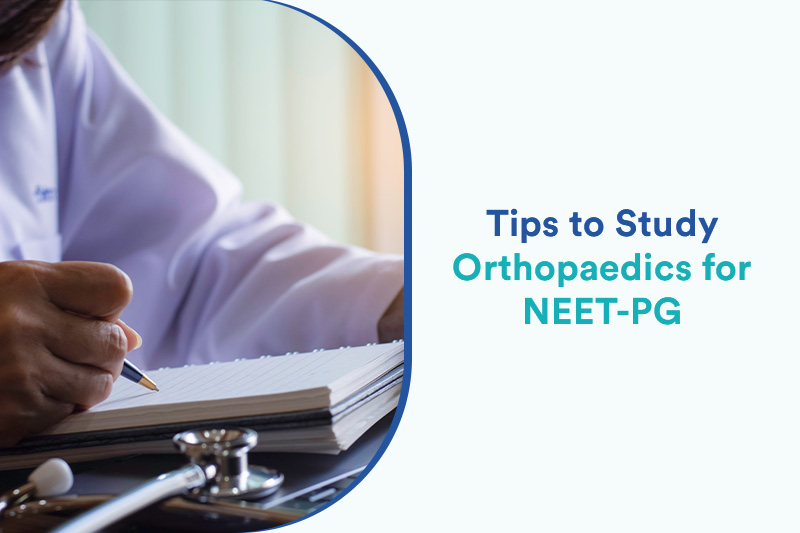One of the brief subjects that a candidate must finish as soon as feasible is orthopaedics. Orthopaedics typically asks simple questions, though AIIMS occasionally asks unique one-liners. Before taking the eagerly anticipated NEET PG Exam, you must plan your NEET PG Exam preparation for Orthopaedics to maximise its effectiveness.
Important Topics to cover in Orthopaedics for NEET PG Exam:
- Imaging – Periosteal Reactions
- Tuberculosis – Pott’s Spine
- Bone Tumors – Diagnosis especially benign tumors & management of malignant tumors
- Traumatology – Upper limb: Shoulder and elbow dislocation, clavicle, humerus, supracondylar humerus, lateral condyle humerus fractures, colles and carpo metacarpal injuries.
- Avascular necrosis and Osteochondritis – Avascular Necrosis
- Metabolic Disorders – Osteomalacia, Osteopetrosis and Pagets, Osteoporosis, Achondroplasia
- Arthritis – Osteoarthritis, RA and ankylosing spondylitis, Gout
- Nerve Injuries – Ulnar
- Pediatrics Orthopaedics – DDH, Perthes, and CTEV
Go through the above-mentioned important topics and crack your entrance exam in one go!
How to study Orthopaedics in MBBS?
- Pay attention to the scope of the syllabus and seek clarity through online orthopaedics lectures or videos in addition to the orthopaedic book for medical students, such as Maheshwari’s Orthopaedics book, that is required for the course. Students will gain a better knowledge of what they will learn during their course as a result, enabling them to make more intelligent decisions.
Key features of Essential Orthopaedics by Maheshwari:
- Includes an annexure on “Clinical Methods,” making it a “one-stop” resource for UG students and residents.
- Free online resources with clinical cases, multiple-choice questions, and practice exams.
- “Additional Information: From the Point of View of Entrance Exams,” which is provided after each chapter.
- The ‘Orthopaedic Terminology’ annexure aids in reviewing the definitions of several terminology used in orthopaedics.
- For a rapid review, key topics under “What Have We Learned?” have been provided at the end of each chapter.
- Several schematics and X-rays have been changed for improved readability.
- Each chapter’s introduction includes competency/learning objectives.
- based on the National Medical Commission’s (NMC) educational curriculum.
- You can summarise and simplify important topics with the use of precise notes. Look for notes that contain several flowcharts, diagrams, case studies, tables, and other illustrations. This will make it easier for you to memorise information and help you retain it for a longer period.
- Regularly evaluate your knowledge to determine the level of your fundamental orthopaedics understanding through a series of assessments. Look for mock tests and practice exams that offer high-yield content.
- Many students are now turning to the inexpensive online orthopaedics for undergrads courses offered in India to master fundamental orthopaedics topics.
Things to Remember
- Be thorough when dealing with orthopaedic tumours, such as by using an X-ray to locate tumours. On the exam, there are questions about uncommon malignancies.
- Questions about pathology and orthopaedics can be found in the NEET PG.
- Peripheral Nerve Regions-related questions. In the NEET PG Exam, 2-3 questions are typically chosen at random. So, you may combine Orthopaedics and Anatomy.
- It is important to carefully read the symptoms and signs associated with an illness.
You may also like
-
Proactive Sourcing Through Embedded Talent: Building Talent Pipelines that Work
-
What accessibility features help disabled patients use a prescription online?
-
How To Choose From The Top Universities In The UK: A 2025 Guide For Global Students
-
Craft Your Resume Using Word Resume Templates: Make Your First Impression Count
-
Deep Dive into Secure Multi-Tenant Architectures for SaaS Platforms
 Proactive Sourcing Through Embedded Talent: Building Talent Pipelines that Work
Proactive Sourcing Through Embedded Talent: Building Talent Pipelines that Work  What accessibility features help disabled patients use a prescription online?
What accessibility features help disabled patients use a prescription online?  How To Choose From The Top Universities In The UK: A 2025 Guide For Global Students
How To Choose From The Top Universities In The UK: A 2025 Guide For Global Students 

